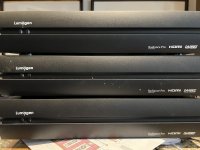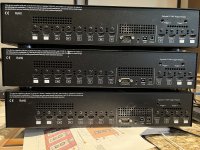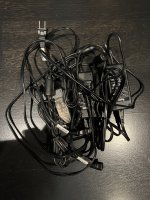I was a beta tester during the Radiance Pro development. The models offered for sale here are the pre-revision models which I am very familiar with. There was one previous version with an earlier design than the model on the listing here but those were only given to the beta testers I believe.
Input and Outputs are modular on this model. There are input and output modules that you can swap and reconfigure relatively easily. Each modules have a pair of input or output connectors.
From the pictures, these units have 1x18Gbps and 3x10.2Gbps input modules, 1x18Gbps and 1x10.2Gbps output modules. Please note that 10.2Gbps modules are marked 9Ghz here. 10.2Gbps bandwidth is adequate for any signal type up to 4k24 HDR at 12 bits or 4k60 HDR at 8 bits (dithered to appear similar to 12 bits).
You need an 18Gbps input for most streaming devices like Apple TV, Roku, Nvidia Shield etc. because they require 4K60 at 12bit capable HDMI chipset on the input device to send HDR signals. Please not that you don't need a matching 18Gbps output card. For example, you can have your Apple TV connected to the 18Gbps input but have your projector connected to the 10.2Gbps output on the Radiance Pro.
You don't need an 18Gbps input for Kaleidescape players or Oppo disc players because they can be configured to work within 10.2Gbps without losing any picture or audio quality.
If you need more 18Gbps inputs and outputs, you can purchase them from Lumagen and easily swap with one of the 10.2Gbps modules.
Switching between devices are faster between different modules than the inputs on the same module. For instance, switching from Input 1 to any input other than Input 2 is quicker than switching from input 1 to 2. If you have less than 8 source devices, It is best to connect them to the odd or even inputs only for fast switching between devices.
Lumagen Radiance Pro has a higher voltage output on its HDMI outputs than most standard source devices. I believe there is a hidden menu to increase it even further but confirm this with the Lumagen support.
You may not need the HDMI extender at all. I would try it with one of the Lumagen Radiance Pro outputs directly into your projector first. On longer cable runs, you will have better luck with 10.2Gbps outputs. I would give the 18Gbps output a try first anyway. If you have no luck in either case then try the HDMI extender after the 18Gbps output.
If you don't want to reconfigure your inputs from the Anthem to The Radiance Pro, you can have the Anthem AVR output connected to one of the 18Gbps Radiance Pro inputs and follow the same directions as above on the Radiance Pro output side.
The reason why you want to connect all your source devices to the Radiance Pro rather than the AVR is simple. You want to send the purest signal to the video processor. Some AVRs do a good job passing through the video signal without alterations while others add multiple signal conversions back and forth to overlay 'volume' and other text. Typically, the inner designs of AVRs are not very well documented on the video side and it is difficult to tell if the output signal matches the input. It is safer to completely bypass the AVR and connect all directly into the Radiance Pro. For example, a Yamaha AVR I used to own was adding visible dither even in the pass through mode.
The next section I am going to type here is a bit for the advance users. So approach with caution and always double check with the Lumagen support before attempting any of it.
The pre-revision I/O board has a bit less voltage drop on the inputs and outputs closer to the FPGA board. You might want to reconfigure the 18Gbps input and output modules so they are closer to the FPGA board. This move is for the most finicky 18Gpbs input and output scenarios. As always, if it ain't broken, don't fix it. If you have good luck without reconfiguring input and output cards, ignore this paragraph.
On the pre-revision vs post-revision Radiance Pro, they are functionally equal. The revisions addressed the voltage regulation on the HDMI modules and the FPGA cooling. The post-revision models are in a 1U chassis vs 2U in height. The asking price on the listing here is so good. I wouldn't worry about the minor changes.






